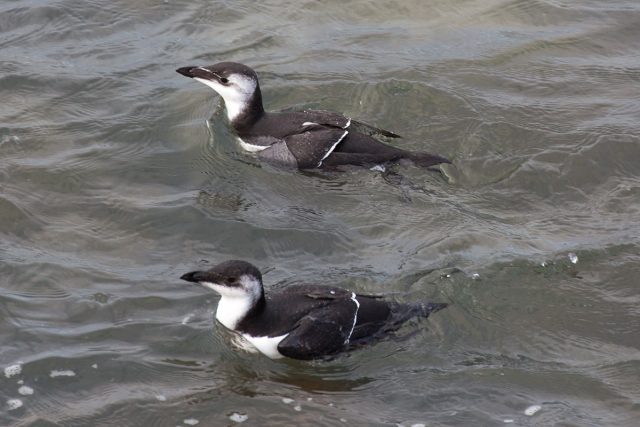· Anglesey ·
Our last full day in Anglesey. It was chilly on the rocks first thing, but very peaceful. A razorbill and a cormorant fished quietly in the bay. House martins buzzed about the low clifftop, occasionally converging for mid-air confabs. They’ll be off soon. I guess many of them have already set off: there have been noticeably fewer swallows and martins this week.
A quick trip to Beaumaris for chips on the pier. As usual, the gulls made a nuisance of themselves, so we had to hide in one of the rain-shelters.
Back to the rocks one final time in the afternoon. I sat on my favourite rock and gazed out to sea for an hour, until I was disturbed by gulls squabbling below. I tried to ignore them, but the squabbling grew louder. I stood to investigate, and realised the whitebait were in: the gulls hovered en masse above the waves, dropping down occasionally into the water to feed. Some whitebait had been thrown up on to the seaweed-covered rocks directly below me, provoking angry confrontations between greedy gulls. Alerted by the commotion, more gulls flew in, accompanied by a couple of cormorants. Then, suddenly, seemingly out of nowhere, razorbills began to appear. I counted twenty, and a couple of guillemots for good measure. A little egret even put in a show—my first at the rocks. It flapped above a floating gull melee, its long legs dangling low, clearly tempted, but decided it was out of its depth and flew off to the far side of the bay.
The feeding frenzy lasted the best part of an hour. I stood on the low cliff, looking directly down on the action, taking photo after photo. I was particularly pleased to observe razorbills up close. Most of them seemed to be juveniles, with only a hint of their future, eponymous, cut-throat-razor-shaped bills. Despite the choppy waves, I could sometimes see the razorbills shooting back and forth beneath the water, using their wings for propulsion. Their similarity to penguins seemed uncanny, although perhaps it shouldn’t: the name penguin was first applied to the razorbill’s nearest relative, the flightless, now sadly extinct, great auk.

Once the frenzy subsided, I toyed briefly with the idea of returning to my favourite rock, but this birds-eye view of seabird action seemed an appropriate point at which to take my leave of the rocks and return to the caravan, after which, tomorrow, it’s back to Yorkshire.
Leave a Reply